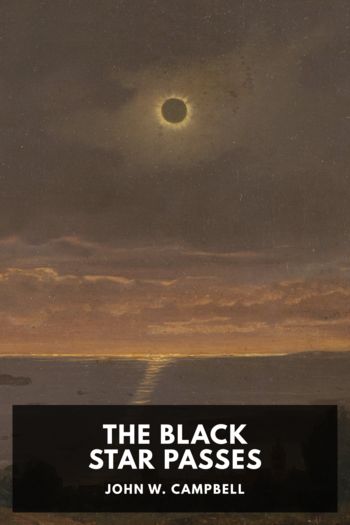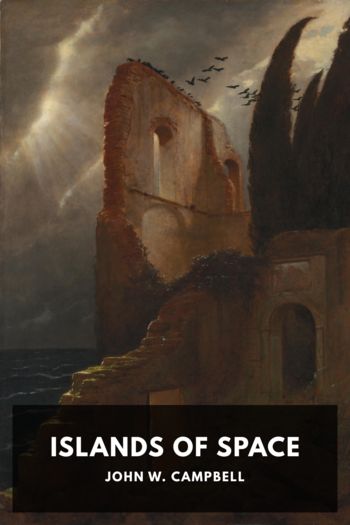The Black Star Passes - John W. Campbell (reading cloud ebooks txt) 📗

- Author: John W. Campbell
Book online «The Black Star Passes - John W. Campbell (reading cloud ebooks txt) 📗». Author John W. Campbell
Not a dissenting voice was raised, so Arcot sent the Solarite nearer.
“But what in the world can we do to that huge thing?” Fuller’s voice came eerily out of the emptiness. “It has perfect invulnerability through size alone.”
There was sudden silence among the Terrestrials as one of the tiny planes darted forward and dove at full speed directly toward one of the giant’s propellers. There were fifty of these strung along each great wing. If enough of them could be destroyed, the plane must crash. There came a terrific crash—a flare of light—and splintered fragments of flaming wreckage plummeted down. Yet the mighty blades continued whirling as smoothly as ever!
What could the Solarite do against the giant monoplane? Evidently Arcot had a plan. Under his touch their machine darted high into the sky above the great plane. There was a full mile between them when he released the sustaining force of the Solarite and let it drop, straight toward the source of the battle—falling freely, ever more and more rapidly. They were rushing at the mighty plane below at a pace that made their hearts seem to pause—then suddenly Arcot cried out, “Hold on—here we stop!”
They seemed a scant hundred feet from the broad metal wings of the unsuspecting plane, when suddenly there was a tremendous jerk, and each man felt himself pressed to the floor beneath a terrific weight that made their backs crack with the load. Doggedly they fought to retain their senses; the blackness receded.
Below them they saw only a mighty sea of roaring red flames—a hell of blazing gas that roared like a score of bombs set off at once. The Solarite was sitting down on her rocket jets! All six of the rocket tubes in the base of the ship had been opened wide, and streaming from them in a furious blast of incandescent gas, the atomic hydrogen shot out in a mighty column of gas at 3,500 degrees centigrade. Where the gas touched it, the great plane flared to incandescence; and in an immeasurable interval the fall of the Solarite ended, and it rebounded high into the air. Arcot, struggling against the weight of six gravities, pulled shut the little control that had sent those mighty torches blasting out. An instant later they sped away lest the plane shoot toward the gas columns.
From a safe distance they looked back at their work. No longer was the mighty plane unscathed, invulnerable, for now in its top gaped six great craters of incandescent metal that almost touched and coalesced. The great plane itself reeled, staggering, plunging downward; but long before it reached the hard soil below, it was brought into level flight, and despite many dead engines, it circled and fled toward the south. The horde of small planes followed, dropping a rain of bombs into the glowing pits in the ship, releasing their fury in its interior. In moments the beings manning the marauder had to a large extent recovered from the shock of the attack and were fighting back. In a moment—just before the ship passed over the horizon and out of sight—the Terrestrians saw the great props that had been idle, suddenly leap into motion, and in an instant the giant had left its attackers behind—fleeing from its invisible foe.
Under Arcot’s guidance the ship from Earth, still invisible, returned to the approximate spot where they had destroyed the invulnerability of the giant. Then suddenly, out of nothing, the Solarite appeared. In an instant a dozen of the tiny two-man planes darted toward it. Just that they might recognize it, Arcot shot it up a bit higher with the aid of the keel rockets at one-third power. The typical reddish flame of atomic hydrogen, he knew, would be instantaneously recognizable.
Little these planes were, but shaped like darts, and swifter than any plane of Earth. They shot along at 1,000 miles an hour readily, as Arcot soon found out. It was not a minute before they had formed a long line that circled the Solarite at minimum speed, then started off in the direction of the city. On impulse Arcot followed after them, and instantly the planes increased their velocity, swiftly reaching 1,000 miles per hour.
The city they were approaching was an inspiring sight. Mighty towers swept graceful lines a half mile in the air, their brightly colored walls gleaming in rainbow hues, giving the entire city the aspect of a gigantic jewel—a single architectural unit. Here was symmetry and order, with every unit in the city built around the gigantic central edifice that rose, a tremendous tower of black and gold, a full half mile in the air.
The outer parts of the city were evidently the residential districts, the low buildings and the wide streets with the little green lawns showing the care of the individual owner. Then came the apartment houses and the small stores; these rose in gentle slopes, higher and higher, merging at last with the mighty central pinnacle of beauty. The city was designed as a whole, not in a multitude of individually beautiful, but inharmonious units, like some wild mixture of melodies, each in itself beautiful, but mutually discordant.
VThe Terrestrians followed their escort high above these great buildings, heading toward the great central tower. In a moment they were above it, and in perfect order the ships of the Venerians shot down to land smoothly, but at high speed. On the roof of the building they slowed with startling rapidity, held back by electromagnets under the top dressing of the roof landing, as Arcot learned later.
“We can’t land on that—this thing weighs too much—we’d probably sink right through it! The street looks wide enough for us to land there.” Arcot maneuvered the Solarite over the edge of the roof, and dropped it swiftly down the half mile to the ground below. Just above the street, he leveled off, and descended slowly, giving the hurrying crowds plenty





Comments (0)